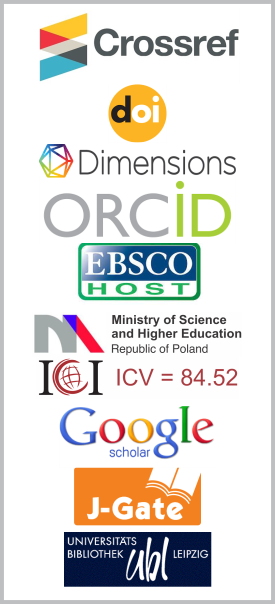Dynamic Epidemiological Models for HIV/AIDS Associated TB Transmission: A Review
DOI:
https://doi.org/10.26713/jims.v17i3.3284Abstract
An extensive literature review suggests a significant link between HIV/AIDS and other diseases such as Pneumocystis pneumonia (PCP), Candidiasis, Cryptococcal meningitis, Toxoplasmosis, and Tuberculosis (TB). Here, our emphasis is on the HIV/AIDS associated Tuberculosis (TB) transmission dynamics. Since the last decade, due to the advancement in machine languages and neural networking, researchers have developed mathematical models to predict and investigate the dynamics of transmission of HIV/AIDS linked Tuberculosis (TB) globally. It includes the therapeutic aspects, like antiretroviral drug screening and treatment factors, in the study. We aim to cover the diversity of developed models to address the numerous key issues of the infection dynamics and provide the status of current and developed models to the global scientific community. Hence, it would help to build highly accurate future models to track the actual dynamics of the concerned disease. In this paper, we discussed deterministic modeling for the HIV/AIDS mediated Tuberculosis (TB) infection dynamics. Additionally, the threshold behaviour and the extended effect of mediations have been discussed. We conclude with an outline of the utilizations and accomplishments of HIV/AIDS-TB modeling and some proposed future directions.
Downloads
References
S. Adeyemo, A. Sangotola and O. Korosteleva, Modeling transmission dynamics of tuberculosis–HIV co-infection in South Africa, Epidemiologia 4(4) (2023), 408 – 419, DOI: 10.3390/epidemiologia4040036.
A. Azeez, J. Ndege, R. Mutambayi and Y. Qin, A mathematical model for TB/HIV co-infection treatment and transmission mechanism, Asian Journal of Mathematics and Computer Research 22(2) (2017), 180 – 192, URL: https://ikprress.org/index.php/AJOMCOR/article/view/1232.
N. Bacaër, R. Ouifki, C. Pretorius, R. Wood and B. Williams, Modeling the joint epidemics of TB and HIV in a South African township, Journal of Mathematical Biology 57(4) (2008), 557 – 593, DOI: 10.1007/s00285-008-0177-z.
C. P. Bhunu, W. Garira and Z. Mukandavire, Modeling HIV/AIDS and tuberculosis co-infection, Bulletin of Mathematical Biology 71(7) (2009), 1745 – 1780, DOI: 10.1007/s11538-009-9423-9.
S. Cassels, S. J. Clark and M. Morris, Mathematical models for HIV transmission dynamics: Tools for social and behavioral science research, Journal of Acquired Immune Deficiency Syndromes 47(Suppl. 1) (2008), S34 – S39, DOI: 10.1097/QAI.0b013e3181605da3.
J. A. Gilbert, E. F. Long, R. P. Brooks, G. H. Friedland, A. P. Moll, J. P. Townsend, A. P. Galvani and S. V. Shenoi, Integrating community-based interventions to reverse the convergent TB/HIV epidemics in rural South Africa, PLOS ONE 10(5) (2015), e0126267, DOI: 10.1371/journal.pone.0126267.
H. W. Hethcote, The mathematics of infectious diseases, SIAM Review 42(4) (2000), 599 – 653, DOI: 10.1137/S0036144500371907.
D. Kirschner, Dynamics of co-infection with M. tuberculosis and HIV-1, Theoretical Population Biology 55(1) (1999), 94 – 109, DOI: 10.1006/tpbi.1998.1382.
M. Kubjane, M. Osman, A. Boulle and L. F. Johnson, The impact of HIV and tuberculosis interventions on South African adult tuberculosis trends, 1990–2019: A mathematical modeling analysis, International Journal of Infectious Diseases 122 (2022), 811 – 819, DOI: 10.1016/j.ijid.2022.07.047.
M. Y. Li, An Introduction to Mathematical Modeling of Infectious Diseases, Vol. 2, Springer Cham, x + 156 pages (2018), DOI: 10.1007/978-3-319-72122-4.
E. F. Long, N. K. Vaidya and M. L. Brandeau, Controlling co-epidemics: Analysis of HIV and tuberculosis infection dynamics, Operations Research 56(6) (2008), 1366 – 1381, DOI: 10.1287/opre.1080.0571.
V. Lusiana, P. S. Putra, N. Nuraini and E. Soewono, Mathematical modeling of transmission co-infection tuberculosis in HIV community, AIP Conference Proceedings 1825(1) (2017), 020012, DOI: 10.1063/1.4978981.
G. G. Muthuri and D. M. Malonza, Mathematical modeling of TB-HIV co infection: Case study of Tigania West sub-county, Kenya, Journal of Advances in Mathematics and Computer Science 27(5) (2018), 1 – 18, Article no. JAMCS.41850, DOI: 10.9734/JAMCS/2018/41850.
L.-I. W. Roeger, Z. Feng and C. Castillo-Chavez, Modeling TB and HIV co-infections, Mathematical Biosciences and Engineering 6(4) (2009), 815 – 837, DOI: 10.3934/mbe.2009.6.815.
P. S. Rivadeneira, C. H. Moog, G. B. Stan, C. Brunet, F. Raffi, V. Ferré, V. Costanza, M. J. Mhawej, F. Biafore, D. A. Ouattara, D. Ernst, R. Fonteneau and X. Xia, Mathematical modeling of HIV dynamics after antiretroviral therapy initiation: A review, BioResearch Open Access 3 (5) (2014), 233 – 241, DOI: 10.1089/biores.2014.0024.
N. H. Shah and J. Gupta, Modelling of HIV–TB co-infection transmission dynamics, American Journal of Epidemiology and Infectious Disease 2(1) (2014), 1 – 7.
N. H. Shah, N. Sheoran and Y. Shah, Dynamics of HIV–TB co-infection model, Axioms 9(1) (2020), 29, DOI: 10.3390/axioms9010029.
S. Shastri, B. Naik, A. Shet, B. Rewari and A. De Costa, TB treatment outcomes among TB–HIV co-infections in Karnataka, India: How do these compare with non-HIV tuberculosis outcomes in the province?, BMC Public Health 13 (2013), Article number: 838, DOI: 10.1186/1471-2458-13-838.
C. J. Silva and D. F. Torres, Modeling TB–HIV syndemic and treatment, Journal of Applied Mathematics 2014(1) (2014), 248407, DOI: 10.1155/2014/248407.
Y. Xiao, H. Miao, S. Tang and H. Wu, Modeling antiretroviral drug responses for HIV-1 infected patients using differential equation models, Advanced Drug Delivery Reviews 65(7) (2013), 940 – 953, DOI: 10.1016/j.addr.2013.04.005.
M. Zhang, A. S. Tseng, G. Anguzu, R. V. Barnabas, J. L. Davis, A. Mujugira, A. D. Flaxmand and J. M. Ross, Modeled estimates of HIV-serodifferent couples in tuberculosis-affected households in four sub-Saharan African countries, PLOS Global Public Health 4(5) (2024), e0002609, DOI: 10.1371/journal.pgph.0002609336.
Downloads
Published
How to Cite
Issue
Section
License
Authors who publish with this journal agree to the following terms:- Authors retain copyright and grant the journal right of first publication with the work simultaneously licensed under a CCAL that allows others to share the work with an acknowledgement of the work's authorship and initial publication in this journal.
- Authors are able to enter into separate, additional contractual arrangements for the non-exclusive distribution of the journal's published version of the work (e.g., post it to an institutional repository or publish it in a book), with an acknowledgement of its initial publication in this journal.
- Authors are permitted and encouraged to post their work online (e.g., in institutional repositories or on their website) prior to and during the submission process, as it can lead to productive exchanges, as well as earlier and greater citation of published work.




